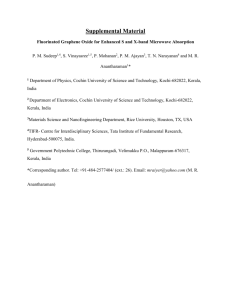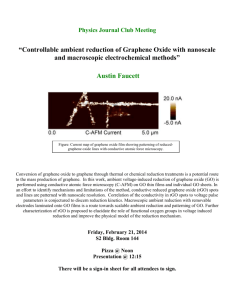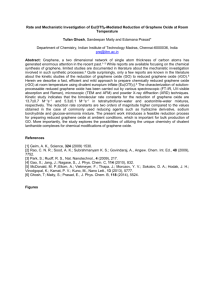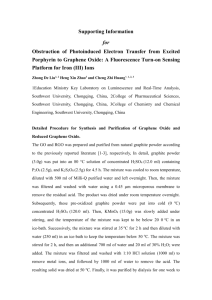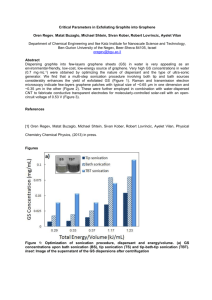Water Soluble Graphene Synthesis
advertisement
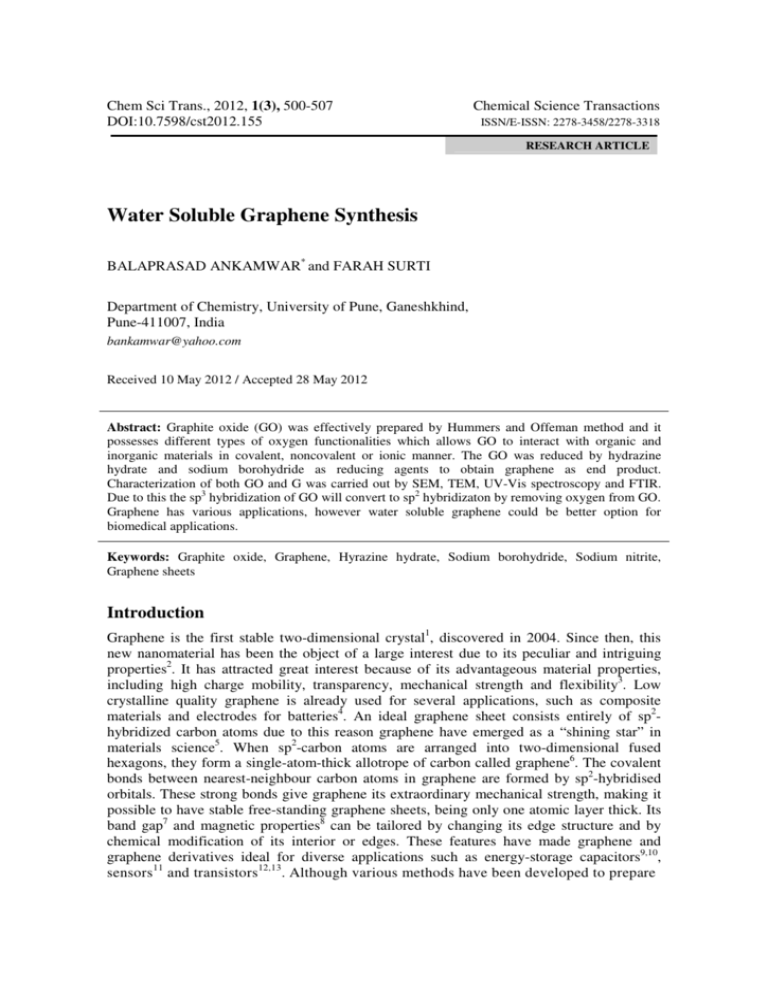
Chem Sci Trans., 2012, 1(3), 500-507 DOI:10.7598/cst2012.155 Chemical Science Transactions ISSN/E-ISSN: 2278-3458/2278-3318 RESEARCH ARTICLE Water Soluble Graphene Synthesis BALAPRASAD ANKAMWAR* and FARAH SURTI Department of Chemistry, University of Pune, Ganeshkhind, Pune-411007, India bankamwar@yahoo.com Received 10 May 2012 / Accepted 28 May 2012 Abstract: Graphite oxide (GO) was effectively prepared by Hummers and Offeman method and it possesses different types of oxygen functionalities which allows GO to interact with organic and inorganic materials in covalent, noncovalent or ionic manner. The GO was reduced by hydrazine hydrate and sodium borohydride as reducing agents to obtain graphene as end product. Characterization of both GO and G was carried out by SEM, TEM, UV-Vis spectroscopy and FTIR. Due to this the sp3 hybridization of GO will convert to sp2 hybridizaton by removing oxygen from GO. Graphene has various applications, however water soluble graphene could be better option for biomedical applications. Keywords: Graphite oxide, Graphene, Hyrazine hydrate, Sodium borohydride, Sodium nitrite, Graphene sheets Introduction Graphene is the first stable two-dimensional crystal1, discovered in 2004. Since then, this new nanomaterial has been the object of a large interest due to its peculiar and intriguing properties2. It has attracted great interest because of its advantageous material properties, including high charge mobility, transparency, mechanical strength and flexibility3. Low crystalline quality graphene is already used for several applications, such as composite materials and electrodes for batteries4. An ideal graphene sheet consists entirely of sp2hybridized carbon atoms due to this reason graphene have emerged as a “shining star” in materials science5. When sp2-carbon atoms are arranged into two-dimensional fused hexagons, they form a single-atom-thick allotrope of carbon called graphene6. The covalent bonds between nearest-neighbour carbon atoms in graphene are formed by sp2-hybridised orbitals. These strong bonds give graphene its extraordinary mechanical strength, making it possible to have stable free-standing graphene sheets, being only one atomic layer thick. Its band gap7 and magnetic properties8 can be tailored by changing its edge structure and by chemical modification of its interior or edges. These features have made graphene and graphene derivatives ideal for diverse applications such as energy-storage capacitors9,10, sensors11 and transistors12,13. Although various methods have been developed to prepare 501 Chem Sci Trans., 2012, 1(3), 500-507 individual graphene sheets, such as chemical vapor deposition (CVD), micromechanical exfoliation of graphite and epitaxial growth on electrically insulating surfaces and many more. However, chemical reduction of graphite oxide colloidal suspensions has been considered as an effective route to synthesize graphene sheets due to its simplicity, reliability, ability for large-scale production and exceptionally low price14. Graphene sheets are expected to have tensile modulus and ultimate strength values similar to those of SWCNTs15. However, obtaining single graphene layers from graphite is a major obstacle. There are reported methods on the production of graphene such as graphitization of SiC16, micromechanical cleavage17 and solution exfoliation of graphite in organic solvents18. However, these methods produce a poor yield of graphene layers. Another method is the oxidation of graphite to graphite oxide which can be easily exfoliated into graphene oxide (GO) layers in solution19 and readily converted back to graphene by chemical reduction20,21. A simple classification as followed using reducing agents as hydroquinone22, dimethylhydrazine19, sodium borohydride23, sulfur containing compounds24, aluminum powder25, vitamin C26, hexamethylenetetramine27, Ethylenediamine (EDA)28, polyelectrolyte29, reducing sugar30, protein31, sodium citrate32, carbon monoxide33, Fe34 and norepinephrine35, performing under various conditions i.e. acid/alkali36, thermal treatment37 and others like microwave38, sonochemical39, laser40, plasmas41, bacterial respiration42, lysozyme43, tea solution44, electrochemical45, electric current46, two-step reduction47 and so on. These different reduction methods result in graphene with different properties. For instance, large-scale production of aqueous graphene dispersion can be easily realized by using hydrazine48 to reduced graphene oxide without the surfactant stabilizers49. GO consists of a hexagonal carbon network having both sp2 and sp3 hybridized carbons bearing hydroxyl and epoxide functional groups on its “basal” plane, whereas the edges are mostly decorated by carboxyl and carbonyl groups50. The exfoliation of graphite oxide produces atomically thin graphene oxide sheets that are dispersible in basic media51. Oxygen functionalities of four kinds are known to exist in GO: epoxide (-O-), hydroxyl (-OH), carbonyl (-CdO) and carboxyl (-COOH). Epoxide and hydroxyl, located on the basal plane of GO, are the major components; carbonyl and carboxyl, distributed at the edges of GO, are minor52. The availability of such functionalities on the basal plane and the sheet edge allows GO to interact with a wide range of organic and inorganic materials in non-covalent, covalent and/or ionic manner so that functional hybrids and composites with unusual properties can be readily synthesized53. Recent literature reported that the electrical conductivity of GO can be significantly increased through removal of the oxygen functional groups by chemical or heat reduction54. The reduction of GO leads to creation of new sp2 clusters, through removal of oxygen, which provide percolation pathways between the 2–3-nm sp 2 domains already present55. It is very difficult to strip graphene sheets from graphite due to the strong bonding between the sheets. Opportunity of oxygenated groups into graphite can reduce this mutual bonding, allowing the exfoliation of graphite oxide (GO) in water by assistance of ultrasonication56. The insulating and defective nature of GO does not allow the observation of fundamental two-dimensional condensed-matter effects, which has restricted the interest of physicists in the material55. Here in our experiment we have used hydrazine hydrate and sodium borohydride as reducing agent and sodium nitrite (NaNO2) was used instead of sodium nitrate (NaNO3) in slightly modified method of hummers and offeman57 for synthesizing GO. Chem Sci Trans., 2012, 1(3), 500-507 502 Experimental Graphite powder was received from Sigma-Aldrich. Concentrated sulfuric acid (98% H2SO4, GR grade), potassium permanganate (KMnO4 purified) and hydrogen peroxide solution (30% H2O2), sodium carbonate (NaCO3, pure), hydrochloric acid (35% HCl. GR grade) were received from MERCK specialities private limited. Sodium nitrite (NaNO2, extrapure), sulphanilic acid (C6H7NO3, AR grade) was received from HIMEDIA Company. Sodium Borohydride (NaBH4, AR grade) was received from RANKEM and hydrazine hydrate (80% N2H5OH, AR grade) was received from CDH private limited. Soap solution and aquaregia was used to clean the apparatus, while MilliQ water was used to rinse the apparatus and also used throughout the experiment. Preparation of graphite oxide Synthesis of graphite oxide The synthesis of graphite oxide from graphite powder was carried out by using Hummers and Offeman method57. Briefly given as: 23 mL of 98% concentrated H2SO4 was cooled down below 0 oC in ice bath for 30-45 min. Separately, 1 g of graphite powder and 0.5 g of NaNO2 was mixed together. This mixture was then added to cool concentrated H2SO4 and kept on constant stirring in an ice bath for 45 min so that the chemicals get sufficient time to get mix with each other. Then after, 3 g of KMnO4 was added slowly and gradually to solution, the solution color immediately turned greenish black in color from black, resulting in oxidation by maintaining the temperature of the solution below 20 oC with constant stirring for 15 min. Removed the solution from the ice bath and allowed to attain the room temperature. After the room temperature was attained the solution was kept under oil-bath with constant stirring and the solution color changes to brown in color. 140 mL of MilliQ water was added followed by addition of 10 mL of 30% H2O2 solution to terminate the reaction and kept on stirring for 15 min where dark brown color was observed in the solution. The solution was kept to settle down for overnight and was centrifuged to obtain the product. Washed solid product several times with 5% of HCl solution to remove impurities and sulfate ions where absence of sulfate ions was detected by using 0.2 M BaCl2 solution. The product was then vaccum dried using Rota vapor at 50 oC to obtain dried product as graphite oxide (GO). Preparation of water soluble graphene 75 mg of above prepared GO was dispersed in 75 g of MilliQ water, the dispersion was then sonicated for 1 h, clear brown colored solution was obtained. Then the pH of solution was adjusted by addition of 5% sodium carbonate solution up to 11. Separately, 600 mg of sodium borohydride solution was obtained by adding 600 mg of NaBH4 in 15 g of MilliQ water and was added to the above prepared dispersion. And kept the aqueous mixture under oil-bath at 80 oC for 1 h with constant stirring. Centrifuged and washed the mixture repeatedly with MilliQ water. Partially reduced graphene solution and change in color from brown to black was observed. Again redispersed the above obtained product into 75 g of MilliQ water and sonicated for few minutes to get properly dispersed solution. Then 46 mg of sulphanilic acid and 18 mg of sodium nitrite was mixed in 10 g of water in a beaker and 0.5 g of 1N HCl solution was taken in separate beaker. Both the beakers were kept in icebath to lower down the temperature of solutions. Then both solutions were mixed together and aryl diazonium salt of orange colored solution was obtained. This mixture was then added to the above dispersed solution which was kept in ice-bath with constant stirring for 2 h. Bubbles were expelled from the mixture after addition of diazonium salt solution. Again the mixture was centrifuged and washed several times with MilliQ water to remove impurities Chem Sci Trans., 2012, 1(3), 500-507 503 and redispersed in 75 g of MilliQ water. And in the last step 2 g of hydrazine hydrate in 5 g of MilliQ water was added to the dispersed solution and kept on stirring for 20 h at 100 oC. It was observed that after every 45 min of stirring and heating at 100 oC, the water starts evaporating so MilliQ water was added to maintain the required volume of mixture till the reaction was completed. Centrifuged the obtained product and washed several times with MilliQ water and complete removal of sulfate ions were confirmed till we get clear solution without turbidity using 5% sodium carbonate solution58. Results and Discussion Absorbance In this work, we chemically synthesized GO using Hummers and Offeman method57 with slight modification by using NaNO2 instead of NaNO3. Among several chemical reductant reported59,60 we choose hydrazine hydrate and sodium borohydride as reducing agents for the reduction of GO to G, which is the majority often used reductant due to its simple reduction procedure and generation of highly reduced graphene oxide with excellent physical properties61. Powder sample of GO was observed in brown color and of graphene were observed in black color. A scanning electron microscope (SEM) image of GO shows flakes like structures in Figure 1(B). The transmission electron microscope (TEM) in Figure 1(C) represents graphene sheets stacked on one another at lower resolution. At higher resolution Figure 1(D) shows the magnified TEM image of Figure 1(C) and HRTEM image of Figure 1(E) clearly shows crystal planes of graphene. Chemical analysis of GO and G was carried out by using UV-Vis spectroscopy and fourier transform infrared spectroscopy (FTIR). The UV-Vis spectra of obtained GO as shown in Figure 1(A) shows band in the wavelength region of 993-1006 nm for GO and shows strongest band at 260 nm, medium band at 808 nm and weak band at 1078 nm. From SEM images i.e. Figure 1(B) flakes of GO was observed. Wavelength, nm Figure 1. (A) UV-Vis spectra of GO (1) and G (2) and inset images shows digital pictures of GO (1) and G (2), (B) shows SEM image of GO, (C) represents lower resolution TEM image of G, (D) higher resolution of (C) and (E) shows HRTEM of (D) Chem Sci Trans., 2012, 1(3), 500-507 504 Figure 2 (C) and (D) show the FTIR spectrum for the obtained GO (black) and G (red) in full range of wavenumbers (400-4000 cm-1) and Close window (800-4000 cm-1) respectively. The presence of different types of oxygen functionalities in GO was confirmed at 3426.65 cm-1 due to O-H stretching vibrations, at 1732.13 cm-1 observed stretching vibrations from C=O, at 1618.33 cm-1, skeletal vibrations from unoxidized graphitic domains were observed and at 1057.02 cm-1 C-O stretching vibrations were analyzed62. Two strong peaks were observed in G, the one at 3433.40 cm-1 were due to O–H stretching vibrations of absorbed water molecules and structural OH groups, the other at 1163.11 cm-1 was of the C–O on the graphene63. b Transmittancr (a.u.) Transmittancr (a.u.) b Wavenumber, cm-1 Wavenumber, cm-1 Figure 2. (A) Full range (400-4000 cm-1) FTIR spectra of GO (black) and G (red), (B) Close window (800-4000 cm-1) of FTIR spectra of GO (black) and G(red) Besides, we also observed peaks such as C=C at 1460.16 cm-1 was assigned to the contribution from the stretching deformation vibration of intercalated water or skeletal vibrations of unoxidized graphitic domains64. Another 2 weak peaks in the spectrum located at 1653.05 cm-1 and 1745.63 cm-1 are attributed to the C= O and O = C–H groups, respectively. The peak at 2953.12 cm-1 corresponds to the C–H group. Given that carboxylic acid groups were unlikely to be reduced these groups should remain in the graphene materials. These observations indicated that oxygen-containing groups existed on the surface of graphene and during the oxidation process of the graphite powder in the concentrated sulfuric acid with potassium permanganate, the original extended conjugated p-orbital system of the graphite were destroyed and oxygen containing functional groups such as hydroxyl, carbonyl and carboxyl groups were inserted into the carbon skeleton65. Moreover, only the broad O–H and the C–O stretching bands were indicating that after a hydrazine reduction process, the GO had been successfully restored to graphene66. Conclusion We prepared graphite oxide (GO) using Hummers and Offeman method58 in which we changed sodium nitrate with sodium nitrite. The preparation of graphene from graphite oxide was done by reduction of hydrazine hydrate instead of hydrazine as it is not stable compound and we obtained stacked graphene sheets, moreover we also changed time parameter from 24 h to 20 h without any water condensor and by adding water to the solution after every 45 min. This method is cheap to prepare graphene on large scale. Charaterization was approved by using SEM, TEM, UV-Vis spectroscopy and FTIR where SEM gives clear image of formation of GO flakes. TEM images shows stacked graphene sheets and planes, UV-Vis spectra shows the peak at 206 nm and FTIR confirms the shifting of groups to form graphene from graphite oxide. Due to its versitality in properties it gives promising results for further applications such as supercapacitors, transistors, water purifier, Chem Sci Trans., 2012, 1(3), 500-507 505 solar cell, hydrogen storage devices, photodetectors, in biomedical application and currently being persuied. We believe that our work will be useful for researchers in this current topic of interest. Acknowledgment FS acknowlwedge to Head, Department of Chemistry and BCUD, University of Pune for funding. Authors acknowledge to Krishna for TEM images and Gunjan Kodwani for helping during our experimental work. References 1. 2. 3. 4. 5. 6. 7. 8. 9. 10. 11. 12. 13. 14. 15. 16. 17. 18. 19. 20. 21. 22. 23. 24. 25. Novoselov K S, Geim A K, Morozov S V, Jiang D, Zhang Y, Dubonos S V, Grigorieva I V and Firsov A A, Science, 2004, 306, 666-669. Geim A K and Novoselov K S, Nat Mater., 2007, 6, 183-191. Geim A K, Science, 2009, 324(19), 1530-1534. Segal M, Nat Nanotechnol., 2009, 4, 612-614. Service R F, Science, 2009, 324, 875. Gao X, Jang J and Nagase S, J Phys Chem C, 2010, 114, 832-842. Son Y, Cohen M and Louie S, Nature, 2006, 444, 347. Fujita M, Wakabayashi K, Nakada K and Kusakabe K, J Phys Soc Jpn., 1996, 65, 1920. Stoller M D, Park S, Zhu Y, An J and Ruoff R S, Nano Lett., 2008, 8, 3498-3502. Yoo E, Kim J, Hosono E, Zhou H S, Kudo T and Honma I, Nano Lett., 2008, 8, 2277-2282. Fowler J D, Allen M J, Tung V C, Yang Y, Kaner R B and Weiller B H, ACS Nano., 2009, 3(2), 301-306. Inanc M, Han M Y, Young A F, Ozyilmaz B, Kim P and Shepard K L, Nat Nanotechnol., 2008, 3, 654-659. Avouris P, Chen Z and Perebeinos V, Nat Nanotech., 2007, 2, 605-615. Krishnan A, Dujardin E, Treacy M, Hugdahl J, Lynum S and Ebbesen T, Nature., 1997, 388, 451-454. McAllister M, Li J, Adamson D, Schniepp H, Abdala A, Liu J, Herrera-Alonso M, Milius D L, Car R, Prud’homme R K and Aksay I A, Chem Mater., 2007, 19, 4396-4404. Forbeaux I, Themlin J M and Debever J M, Phys Rev B., 1998, 58(24), 16396-16406. Novoselov K S, Jiang D, Schedin F, Booth T J, Khotkevich V and Morozov S, Proc Natl Acad Sci U S A, 2005, 102(30), 10451-10453. Hernandez Y, Nicolosi V, Lotya M, Blighe F M and Sun Z, Nat Nanotech., 2008, 3(9), 563-568. Stankovich S, Dikin D, Dommett G, Kohlhaas K, Zimney E and Stach E, Nature, 2006, 442, 282-286. Gilje S, Han S, Wang M, Wang K L and Kaner R B, Nano Lett., 2007, 7(11), 3394-3398. Gomez-Navarro C, Weitz R T, Bittner A M, Scolari M, Mews A, Burghard M and Kern K, Nano Lett., 2007, 7(11), 3499-3503. Wang G, Yang J, Park J, Gou X, Wang B, Liu H and Yao J, J Phys Chem C, 2008, 112, 8192-8195. Si Y and Samulski E T, Nano Lett., 2008, 8(6), 1679-1682. Zhou T, Chen F, Liu K, Deng H, Zhang Q, Feng J and Fu Q, Nanotechnol., 2011, 22(4), 045704. Fan Z, Wang K, Wei T, Yan J, Song L and Shao B, Carbon, 2010, 48, 1686-1689. Chem Sci Trans., 2012, 1(3), 500-507 26. 27. 28. 29. 30. 31. 32. 33. 34. 35. 36. 37. 38. 39. 40. 41. 42. 43. 44. 45. 46. 47. 48. 49. 50. 51. 52. 53. 54. 55. 56. 57. 506 Fernandez-Merino M J, Guardia L, Paredes J I, Villar-Rodil S, Solis-Fernandez P, Martinez-Alonso A and Tascon J M D, J Phys Chem C, 2010, 114, 6426-6432. Shen X P, Jiang L, Ji Z Y, Wu J L, Zhou H and Zhu G X, J Colloid Interface Sci., 2011, 354, 493-497. Che J, Shen L and Xiao Y, J Mater Chem., 2010, 20, 1722-1727. Zhang S, Shao Y, Liao H, Engelhard M H, Yin G and Lin Y, ACS Nano., 2011, 5, 1785–1791. Zhu C, Guo S, Fang Y and Dong S, ACS Nano., 2010, 4(4), 2429–2437. Liu J, Fu S, Yuan B, Li Y and Deng Z, J Am Chem Soc., 2010, 132, 7279–7281 Wan W B, Zhao Z B, Hu H, Zhou Q, Fan Y R and Qiu J S, New Carbon Mater., 2011, 26(1), 16-20. Ai K, Liu Y, Lu L, Cheng X and Huo L, J Mater Chem., 2011, 21, 3365–3370. Fan Z J, Kai W, Yan J, Wei T, Zhi L, Feng J, Ren Y, Song L and Wei F, ACS Nano., 2011, 5, 191-198. Kang S M, Park S, Kim D, Park S Y, Ruoff R S and Lee H, Adv Funct Mater., 2011, 21(1), 108–112. Pei S, Zhao J, Du J, Ren W and Cheng H M, Carbon, 2010, 48, 4466-4474. Dubin S, Gilje S, Wang K, Tung V C, Cha K, Hall A S, Farrar J, Varshneya R, Yang Y and Kaner R, ACS Nano., 2010, 4, 3845–3852. Chen W, Yan L and Bangal P R, Carbon, 2010, 48, 1146–1152. Vinodgopal K, Neppolian B, Lightcap I V, Grieser F, Ashokkumar M and Kamat P V, J Phys Chem Lett., 2010, 1, 1987–1993. Sokolov D A, Shepperd K R and Orlando T M, J Phys Chem Lett., 2010, 1, 2633–2636. Baraket M, Walton S G, Wei Z, Lock E H, Robinson J T and Sheehan P, Carbon, 2010, 48, 3382–3390. Salas E C, Sun Z, Luttge A and Tour J M, ACS Nano, 2010, 4(8), 4852–4856. Yang F, Liu Y Q, Gao L and Sun J, J Phys Chem C, 2010, 114, 22085–22091. Wang Y, Shi Z and Yin J, ACS Appl Mater Interfaces, 2011, 3, 1127–1133. Wang Z, Zhou X, Zhang J, Boey F and Zhang H, J Phys Chem C, 2009, 113, 14071-14075. Yao P, Chen P, Jiang L, Zhao H, Zhu H, Zhou D, Hu W, Han B and Liu M, Adv Mater., 2010, 22, 5008–5012. Gao W, Alemany L. B, Ci L and Ajayan P M, Nature Chem., 2009, 1, 403–408. Gomez-Navarro C, Weitz R T, Bittner A M, Scolari M, Mews A, Burghard M and Kern K, Nano Lett., 2007, 7, 3499–3503. Li D, Mueller M B, Gilje S, Kaner R B and Wallace G G, Nature Nanotechnol., 2008, 3(2), 101–105. Won J S, Piner R D, An J and Ruoff R S, ACS Nano., 2010, 4, 6557–6564. Brodie B C, Phil Trans R Soc Lond A, 1859, 149, 249–259. Szabo´ T, Berkesi O, Forgo P, Josepovits K, Sanakis Y, Petridis D and De´ka´ny I, Chem Mater., 2006, 18, 2740. Park S and Ruoff R, Nature Nanotech., 2009, 4, 217–224. Watchrotone S, Dikin D, Stankovich S, Piner R, Jung I, Dommetta S, Evmenenko G, Wu S, Chen S, Liu C, Nguyen S and Ruoff R, Nano Lett., 2007, 7, 1888-1892. Loh K P, Bao Q L, Eda G and Chhowalla M, Nat Chem., 2010, 2, 1015-1024. Titelman G, Gelman V, Bron S, Khalfin R L, Cohen Y and Bianco-Peled H, Carbon, 2005, 43, 641–649. Fan W, Lai Q, Zhang Q and Wang Y, J Phys Chem C, 2011, 115, 10694-10701. 507 Chem Sci Trans., 2012, 1(3), 500-507 58. 59. 60. 61. Si Y and Edward T Samulski, Nano Lett., 2008, 8(6), 1679-1682. Park S and Ruoff R S, Nat Nanotechnol., 2009, 4, 217–224. Moon I, Lee J, Ruoff R and Lee H, Nat Commun., 2010, 1, 1-6. Park S, An J H, Jung I W, Piner R D, An S J and Li X S, Velamakanni A and Ruoff R S, Nano Lett., 2009, 9, 1593. Choi E Y, Han T H, Hong J, Kim J E, Lee S H, Kim H W and Kim S, J Mater Chem., 2010, 20, 1907–1912. Zhang Y P, Li H B, Pan K L, Lu T and Sun Z, J Mater Chem., 2009, 19, 6773. Guo H L, Wang X, Qian Q, Wang F and Xia X, ACS Nano., 2009, 3, 2653-2659. Lian P, Zhu X, Liang S, Li Z, Yang W and Wang H, Electrochim Acta, 2010, 55(2), 3909-3914. Yan J, Zhao J and Pan L, Phys Status Solidi A, 2011, 208, 2335-2338. 62. 63. 64. 65. 66.


